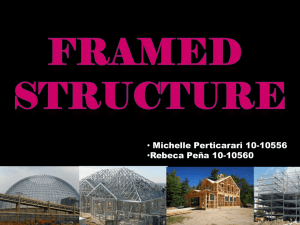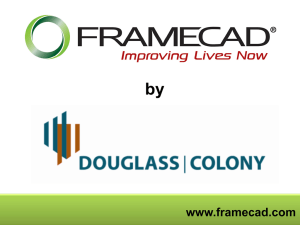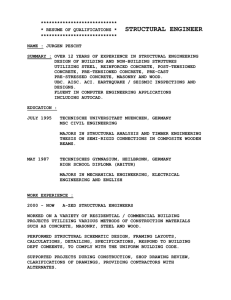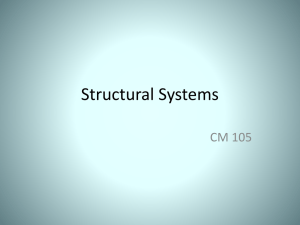Commercial Framing Systems
advertisement
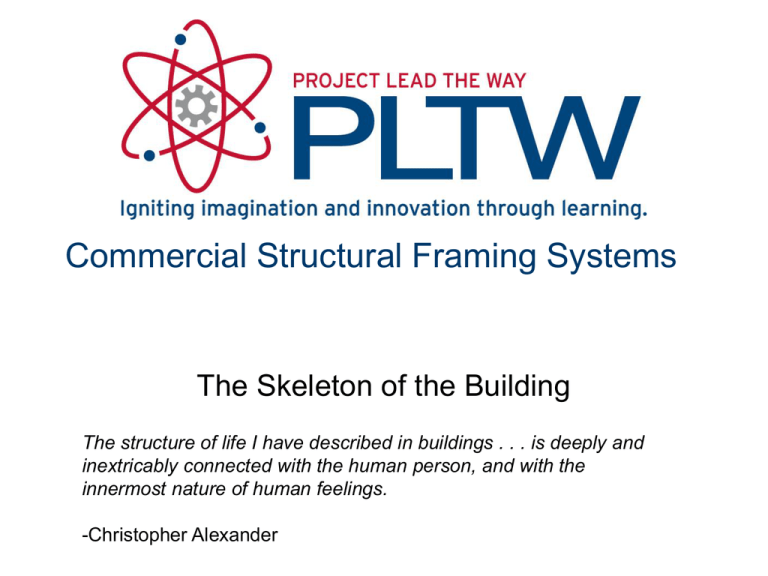
Commercial Structural Framing Systems The Skeleton of the Building The structure of life I have described in buildings . . . is deeply and inextricably connected with the human person, and with the innermost nature of human feelings. -Christopher Alexander Commercial Structural Framing Systems •Purpose •Low Rise Framing Systems •Cast-in-Place Concrete •Structural Steel •Load Bearing Walls •Hybrid Systems •Cost •Structural Efficiency PURPOSE •The purpose of structural framing is provide • Strength – Holds the structure up (and holds it down) despite • Gravity (vertical) loads • Lateral (sideways) loads • Stability – Maintains the shape and minimizes movement Commercial Framing Systems •Low Rise (three stories or less) commercial framing systems may be similar to residential construction • Wood framing • Light gauge steel framing Commercial Framing Systems However, usage of commercial buildings often differs from residential usage. •Commercial building considerations • Heavy traffic • Heavier loads • More wear and tear • Larger open spaces • Easy Maintenance Common Commercial Framing Systems Cast-inStructural Place Steel Concrete Framing Framing Load Bearing Walls Hybrid Systems Cast-in-Place Concrete Forms are built Reinforcing is placed Concrete is poured and finished in place Wooden forms used to cast slabs ©iStockphoto.com Cast-in-Place Concrete Frame Concrete Column Structural Concrete Slab Structural Steel Structural members are fabricated off site Members are delivered to the site Members are erected per the design ©iStockphoto.com Structural Steel Framing Structural Steel Column Lateral Brace Open Web Steel Roof Joists Steel Decking Structural Steel Floor Beams Courtesy Connie Bertucci Load Bearing Walls • Masonry Courtesy IOP Rec Center Masonry load bearing walls with light gauge steel trusses Load Bearing • Pre-cast concrete Walls • Tilt-up concrete Courtesy Tilt-up Concrete Association Floor and Roof Tilt-up load bearing walls with structural steel and open web steel joist floor and roof framing • Wood Framing • Light Gauge Steel Framing • Structural Steel Load Bearing Walls Open Web Wood Floor Joists Courtesy Carolina Concrete Masonry Association Load Bearing CMU Wall Hybrid Framing Systems Structural Steel Framing Cast-in-Place Concrete Load Bearing Walls Courtesy TexAZ Business Park Hybrid Systems combine two or more different framing systems Cost • The cost of construction is an important consideration when choosing a structural system • The cost of a structure is directly related to the weight of materials used to build the structure • Lower material weight = Lower cost • Higher material weight = Higher cost Structural Efficiency • Ratio of the maximum design load that a structure will carry to the weight of the structure itself • Higher structural efficiency means less material weight = Lower cost • Lower structural efficiency means more material weight = Higher cost Maximum Design Load Structural Efficiency Weight of Structure Design Load = Load a structure is designed to carry Commercial Structural Framing Systems •Purpose •Low Rise Systems •Cast-in-Place Concrete •Structural Steel •Load Bearing Walls •Hybrid Systems •Cost •Structural Efficiency References Ching, Francis D. K., and Cassandra Adams. Building Construction Illustrated, 3rd Edition. (2000) New York: Wiley. Ramsey, Charles George. Ramsey/Sleeper architectural graphics standards. (2000) New York: John Wiley. Image Sources • Tilt Up Concrete Association. http://www.tilt-up.org/ • iStockphoto. http://www.istockphoto.com/index.php • Connie Bertucci, Victor Senior High School, Victor, NY • TexAZ Commercial Properties, LLC • Carolinas Concrete Masonry Association. http://ccmaonline.com/about-carolinas-concrete/aboutus.htm
